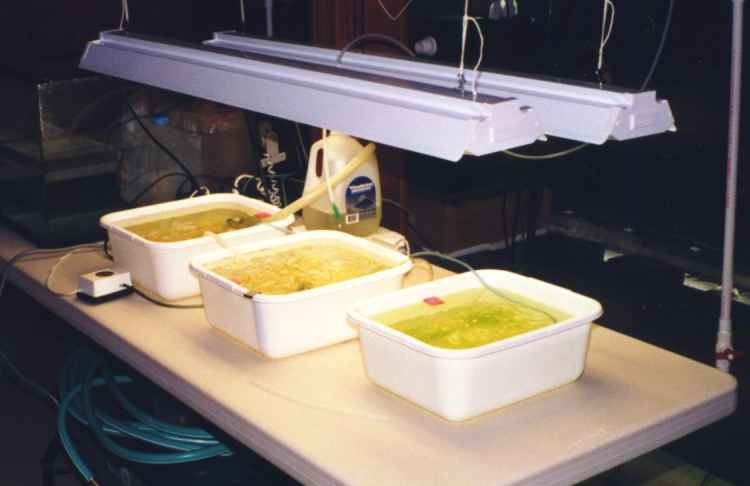
Iíve talked a lot about spawning goldfish in earlier articles. Breeding goldfish is far and away the most interesting part of keeping goldfish for me. It is also the most frustrating part; it is the epitome of the saying "experience is what you get when you didnít get what you wanted". My 1999 experiences continue to bear this out.
I did three hand spawnings in early July. Long term, I want to have a good strain of Japanese Ranchu. But, for various reasons that could fill another article, I donít have a breedable female Japanese Ranchu. But I do have a strain of Chinese Ranchu-Lionheads (the breeding results are so variable I can select for either variety) with a lot of females. So I did three spawns: Chinese X Chinese for the most "Lionhead-like" fish, Chinese X Chinese for Ranchu-ish fish, and a Japanese Ranchu male X Chinese female to try to at least gradually move towards the traditional Japanese look.

Above: An improved hatching setup for 1999. Features: good lighting, easy to clean, and a drip/overflow water changing system. The fry were kept in the 3-gallon containers for about 10-days, then culled and moved to 11-gallon plastic boxes.
I use a "dry spawning" technique I have discussed previously. This normally lets me (a) be very precise about who the parents are, and (b) get very high egg fertility rates with very small amounts of milt from the males (usually more than 90% fertile). Under this scenario, I can hatch out three or four hundred eggs in a few gallons of water with no problems.
But this year I tried to spawn a particularly recalcitrant (and large and hard to handle) male, getting virtually no milt out of him at all. The resulting spawn for this particular crossing had only about 30% fertility, while the other two spawns were the normal 90-plus percent. I have always read about issues with egg fungus, the use of methylene blue, water changing, and other aspects of egg care, but have never really had to worry about it before.
But, boy, this low fertility spawn was a completely different story! Within a couple of days the water was foul, there was rampant egg fungus, and in general the whole setup was a mess. The highly fertile spawns in containers along side had no problems. I had to start doing water changes, removing bad eggs, and adding chemicals, and then when the fry hatched, I had to get the spawning material out of the hatching container as soon as possible (normally I leave it in for a week, until the fry are strongly free swimming). I now understand some of the issues that people who naturally spawn (with 50-60 percent fertility) have to contend with. The moral for me was that having high fertility spawns is a big labor savings, if nothing else.
This page hosted by ![]() Get your own Free Home Page
Get your own Free Home Page